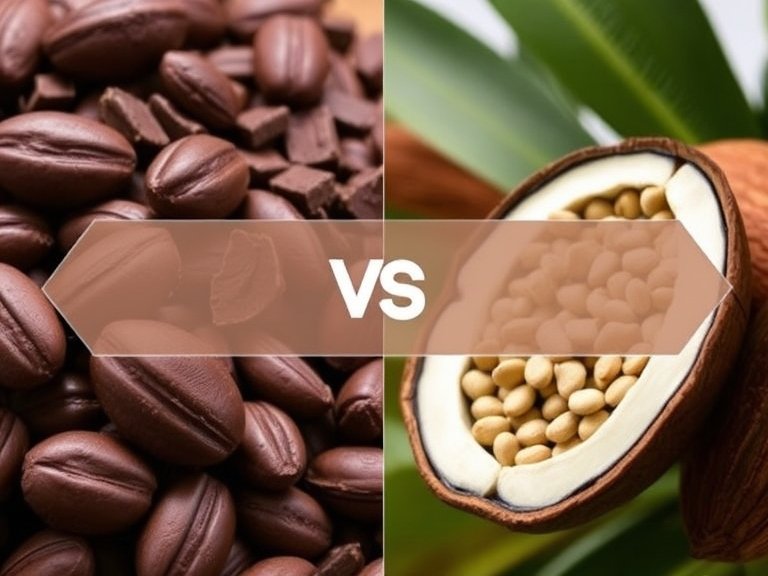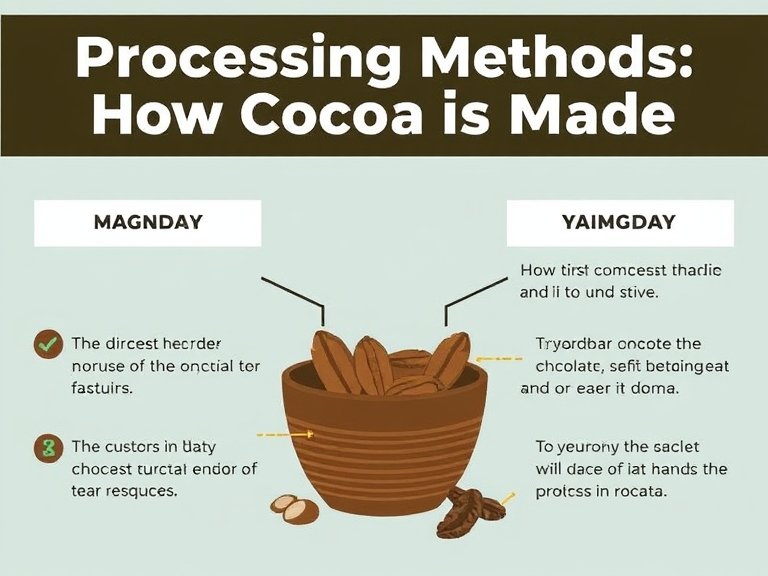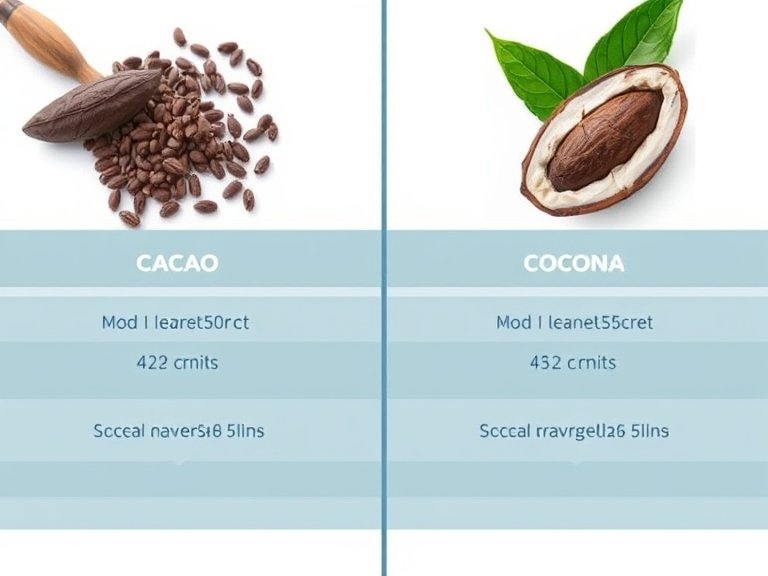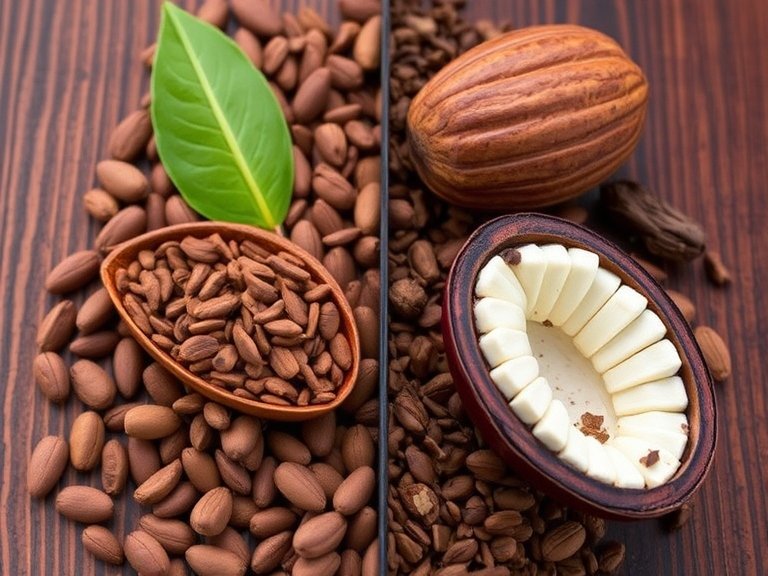Welcome to your comprehensive guide to the fascinating world of cacao and cocoa. This article will explore the key differences, health benefits, and uses of these popular ingredients that have captivated humans for thousands of years.
Understanding the Basics: What Are Cacao and Cocoa?
Cacao refers to the raw, unprocessed form of chocolate. These beans come from the Theobroma cacao tree, native to South America’s tropical regions. Farmers harvest the pods, remove the beans, and then ferment and dry them to create raw cacao.
Cocoa, on the other hand, is what you get after processing raw cacao at high temperatures. This processing changes both the taste and nutritional content of the final product. Most store-bought chocolate products contain cocoa rather than raw cacao.
The Journey from Bean to Bar
The transformation of cacao beans into chocolate products involves several steps. First, workers harvest the large pods from cacao trees. Each pod contains 20-40 beans surrounded by white pulp. After harvesting, the beans undergo fermentation for 5-7 days.
After fermentation, farmers dry the beans in the sun for several days. This crucial step develops the beans’ flavor and reduces their moisture content. The dried beans then travel to manufacturing facilities for processing into various chocolate products.
Nutritional Differences Between Cacao and Cocoa

Raw cacao contains more nutrients than processed cocoa. It offers higher levels of antioxidants, minerals, and beneficial compounds. These nutrients remain intact because the beans haven’t been exposed to high temperatures.
Cacao provides significant amounts of magnesium, iron, and calcium. It also contains protein, fiber, and healthy fats. The antioxidants in cacao, called flavonoids, help protect your cells from damage and may reduce inflammation.
Health Benefits of Raw Cacao
Raw cacao offers numerous health benefits thanks to its rich nutrient profile. Regular consumption may improve heart health by reducing blood pressure and improving blood flow. The flavonoids in cacao help maintain healthy blood vessel function.
Studies suggest that cacao can enhance brain function and mood. It contains compounds that increase serotonin levels, often called the “happy hormone.” These compounds may also help improve focus and reduce stress.
Processing Methods: How Cocoa is Made

To make cocoa powder, manufacturers roast cacao beans at high temperatures. This process changes the beans’ chemical structure and creates the familiar chocolate flavor we know. After roasting, they remove the beans’ outer shells and grind them into a paste.
The paste undergoes further processing to separate cocoa solids from cocoa butter. The remaining solids are ground into powder, which becomes cocoa powder. This processing reduces some nutritional benefits but creates a more shelf-stable product.
Uses in Cooking and Baking
- Raw Cacao Applications:
- Add to smoothies for a nutrition boost
- Mix into energy balls and bars
- Use in raw dessert recipes
- Sprinkle on oatmeal or yogurt
- Blend into homemade nut milk
- Cocoa Powder Uses:
- Bake cakes, cookies, and brownies
- Make hot chocolate
- Create chocolate sauces
- Flavor ice cream
- Dust desserts as a garnish
Making Healthy Choices with Chocolate Products
When choosing between cacao and cocoa products, consider your health goals and intended use. Raw cacao offers more nutritional benefits but has a stronger, more bitter taste. It works well in health-focused recipes and smoothies.
Cocoa powder suits traditional baking and cooking better. While it contains fewer nutrients than raw cacao, it still offers health benefits when consumed as part of a balanced diet. Choose unsweetened cocoa powder to avoid added sugars.
Storage and Shelf Life
Proper storage helps maintain the quality of both cacao and cocoa products. Keep them in airtight containers in a cool, dry place away from direct sunlight. Raw cacao products typically have a shorter shelf life due to their minimal processing.
Cocoa powder can last up to two years when stored properly. Check for signs of moisture, unusual odors, or clumping, which indicate spoilage. Always check expiration dates and follow storage instructions on packaging.
Environmental Impact and Sustainability
The growing demand for chocolate products affects the environment and farming communities. Sustainable cacao farming practices help protect rainforests and support farmer livelihoods. Look for products with fair trade and organic certifications.
Many companies now focus on ethical sourcing and environmental responsibility. These efforts help ensure the long-term sustainability of cacao production while protecting natural resources and supporting local communities.
Economic Aspects of Cacao and Cocoa Production
The chocolate industry significantly impacts the global economy. Cacao farming provides income for millions of people, particularly in West Africa. Understanding the economic aspects helps consumers make informed choices about their chocolate purchases.
Price differences between raw cacao and cocoa products reflect processing costs and market demand. Raw cacao products often cost more due to their minimal processing and higher nutrient content.
Cultural Significance Throughout History
Ancient civilizations valued cacao beans as currency and used them in sacred ceremonies. The Mayans and Aztecs believed cacao had divine origins and used it in religious rituals. This rich cultural heritage continues to influence modern chocolate appreciation.
Today, chocolate plays an important role in various cultural celebrations worldwide. Understanding its history helps us appreciate the significance of both cacao and cocoa in human civilization.
Future Trends in Cacao and Cocoa Products

The chocolate industry continues to evolve with changing consumer preferences. The growing interest in healthy eating drives demand for raw cacao products. Manufacturers develop new products that balance nutrition with taste.
Innovation in processing methods aims to preserve more nutrients while improving flavor. Research continues to explore potential health benefits and applications of both cacao and cocoa products.
Tips for Choosing Quality Products
Look for products with minimal ingredients when buying raw cacao. High-quality cacao should have a rich aroma and natural brown color. Avoid products with added sugars or artificial ingredients.
For cocoa powder, choose options labeled “natural” or “unsweetened.” Dutch-processed cocoa undergoes additional processing that affects its nutritional content. Read labels carefully to make informed choices.
Health Considerations and Precautions
While cacao and cocoa offer health benefits, moderation remains important. Some people may be sensitive to caffeine or other compounds in these products. Consult healthcare providers if you have concerns about adding them to your diet.
Pregnant women and people with certain medical conditions should discuss cacao consumption with their doctors. Always start with small amounts when trying raw cacao for the first time.
Frequently Asked Questions
Is raw cacao safe to eat?
Yes, raw cacao is safe for most people when consumed in moderation.
Can I substitute cocoa powder for raw cacao?
Yes, but you may need to adjust quantities as raw cacao has a stronger flavor.
Does raw cacao contain caffeine?
Yes, it contains small amounts of caffeine and theobromine.
How much cacao should I consume daily?
Most experts recommend 1-2 tablespoons of raw cacao per day.
Can cacao help with weight loss?
Raw cacao may support weight management as part of a balanced diet.
Conclusion
Understanding the differences between cacao and cocoa helps make informed choices about chocolate products.
Raw cacao offers more nutritional benefits, while cocoa provides versatility in cooking and baking.
Both ingredients contribute valuable nutrients and enjoyment to a balanced diet.
Consider your health goals, intended use, and personal preferences when choosing between cacao and cocoa products. Remember that quality and sourcing matter for both environmental impact and nutritional benefits.
Whether you choose raw cacao for its health benefits or cocoa for its familiar taste, both options offer unique advantages in their own right.
The future of chocolate products continues to evolve with growing interest in health and sustainability.
By understanding these powerful facts about cacao and cocoa, you can make choices that align with your health goals while enjoying the wonderful world of chocolate.

